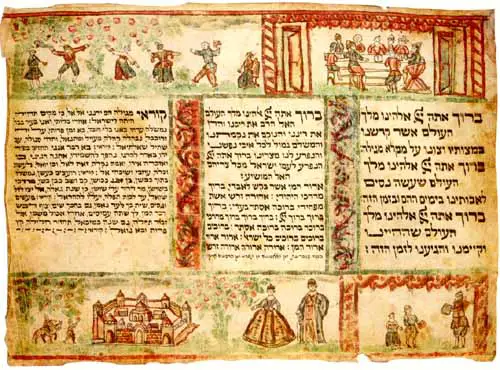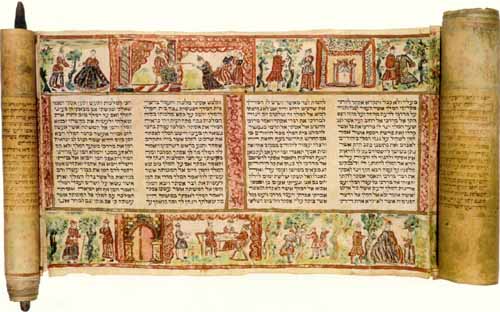Adding Beauty to Holiness: An Illuminated Megillah
The Jewish attitude to visual art is well described by art historian Bezalel Narkiss in his introduction to Hebrew illuminated Manuscripts, Jerusalem, 1969:
It is generally assumed that Jews have an aversion to figurative art. This assumption is, in a way, true, since Jewish life in accordance with the halakah, has been directed toward belief and righteous behavior, with a verbal rather than visual expression of its tenets.
However, artistic expression, far from being prohibited, was actually encouraged, either for educational purposes or for what is known as hiddur mitzvah, that is, adornment of the implements involved in performing rituals. Once these reasons were established, a place for artistic expression was found in Judaism. Gradually, the art gathered momentum. Embellishing biblical, ritual, legal, or even Hebrew secular books and manuscripts was one of the most important ways in which a Jew could express his devotion to the written word.
The special adornment of objects employed in ritual observance is most pronounced in the illustration and illumination of the Purim megillah, the Passover Haggadah, and the marriage ketubah. From the Hebraic Section of the Library, we draw notable examples of these as well as a most interesting illuminated Shivviti tablet, and a representation of the most Jewish of art forms, micrography.The most joyous of Jewish holidays is the Festival of Purim. It is a day for merriment-eating and drinking, "until one can no longer discern between blessed Mordecai and accursed Haman"--a day of exchanging gifts and giving charity to the poor. It commemorates the events in ancient Persia described in the Biblical Book of Esther: The great monarch King Ahasuerus, whose kingdom extends from "India unto Ethiopia," in a moment of rage, deposes his queen Vashti, then sets about choosing another in her stead, the queenly post being won by the fair young maiden Esther, who, unbeknown to the king, is a Jew. Ahasuerus then raises a certain Haman to be his chief minister. Mordecai, cousin of the new queen, refuses to bow to the imperious Haman, who determines to punish not only Mordecai but his whole people with him. Through the intercession of Queen Esther-as well as the fortuitous saving of the king's life by Mordecai-Haman's wicked plan, the destruction of all the Jews in the realm, is thwarted, and turned against him. By royal decree, the Jews are permitted to defend themselves, and Haman and his sons are hanged. Mordecai is raised to highest station, and sends lettersunto all Jews that were in the provinces of the King ... enjoining them that they should keep ... the days wherein the Jews had rest from their enemies ... days turned from sorrow to gladness, from mourning to rejoicing ... that they should make them days of feasting and gladness, of sending portions one to another, and gifts to the poor.
Esther 9:20-22
The fourteenth day of the month of Adar, the day which Haman had chosen by lots (Hebrew: purim) for the destruction of the Jews, became a day to celebrate their being rescued. In time Purim became a holiday celebrating salvation from evil decrees and threats of annihilation wherever and whenever they occurred in the long history of persecution of the Jewish people, for, as the Haggadah reminds Jews each Passover, "In every generation, they rise up to destroy us, but the Holy One, Blessed be He, saves us from them."The festival is not only celebrated in the home through feasting and merrymaking but commemorated in the synagogue as well through special additions to the liturgy and most importantly through the evening and morning reading of the Book of Esther from a megillah scroll. The scroll read in the synagogue contains the text alone, without illustration or decoration, but individual Jews began to commission such scrolls with ornamentation and illumination from the seventeenth century on in middle and southern Europe, and later in the Near East. Some of these were accompanied by a special sheet containing the blessings recited before and after the reading, and most incorporated hymns.
An Illuminated Megillah
Among the dozen scrolls of the Book of Esther in the Library is one which is both illustrated and illuminated on fine vellum, accompanied by a sheet of blessings.The blessings are the traditional ones, to which the scribe appends a listing of those to be cursed and blessed. And in tiny letters he offers this plea: "As thou hast taken retribution against our ancient [enemies], do so against the evil doers now and in the future, Amen!"The scribe also adds an acrostic poem, whose verses begin with the letter ABRM, by the biblical commentator, grammarian, and poet Abraham Ibn Ezra, which is included in some Sefardi liturgies to be recited before the reading of the megillah, or on the Sabbath of Remembrance before Purim, Shabbat Zakhor. it is found in no less than seven manuscripts of comprehensive prayer books from Algiers and the Yemen, and its refrain reads: "Those who read the megillah, sing joyous songs to God, for it was a time of exultation for Israel." From Babylonian exile to Messianic redemption is its theme; at the center of the drama is the confrontation between Haman and Mordecai.
 |
Above the blessing, in pleasing colors, is a scene of seven men and two women seated around a table at which a man is apparently reading to them from one of several open books. Doors are open on either side of the room. Above the poem is a scene of two men and two women dancing in a garden; on either side is a musician playing a horn. One man has doffed his hat. Below the blessings is a picture showing a man reading from a book to a boy and a girl. In the center are a crowned king and queen in royal dress. Under the poem, which ends with "May the Redeemer arrive," is a depiction of the walled city of Jerusalem. On the way to the city is a man on a donkey, before whom a herald sounds his shofar. It is the Messiah about to enter the Holy City.Both the scene at the table and the Messiah at Jerusalem are copied from the Venice Haggadah of 1609, 1629, 1695, or 1740, though there is one more person and books have replaced food on the table. Musicians and mixed dancing also point to the Italian provenance of the megillah and its sheet of blessings. Cecil Roth describes northern Italian "Jews and the ... theater, music and dance" in his The Jews and the Renaissance. Later Italian rabbis often inveighed against their flock for having surrendered to "the ways of the environment."
 |
The megillah is illustrated with scenes from the biblical narrative. Vashti, the queen, as commentators suggest, was to have appeared without clothes. She refused, but our artist complies. The illustrations unfold before us scenes at the court, Esther before Ahasuerus, battles being waged, and musicians playing. The full drama of the narrative is brought to life by the eighteenth-century north Italian landscape, its recognizable buildings, dress, furnishings, and martial and musical instruments-lance and viol. Ahasuerus and Vashti, Haman and Zeresh, Mordecai and Esther become contemporaries. The illustrations do not intrude upon the text; they give it life. Alas, we know nothing of the illustrator-scribe, not even his name.
Sources: Abraham J. Karp, From the Ends of the Earth: Judaic Treasures of the Library of Congress, (DC: Library of Congress, 1991).


